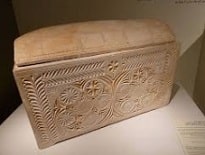 The late Latin word ossarium came into Spanish as ossuary . This is what the place where there are bones is called.
The late Latin word ossarium came into Spanish as ossuary . This is what the place where there are bones is called.
The term usually refers specifically to the place or container that, in a cemetery or a church , houses the bones that are extracted from a grave. The ossuary, in this sense, is a space that serves to store bone pieces .
The use of ossuaries was traditional among the Jewish people . In the ancient times of this community, the body of the deceased person was shrouded and ointments and oils were applied to it. He was then placed in a tomb made up of two chambers. After a year, the bones were searched by the relatives of the deceased and placed in an ossuary, which was installed in a hole or altar in the other chamber of the tomb.
These ossuaries were decorated with symbols of the Jewish faith . Sometimes the name of the individual was also carved. As for the bones, the smallest ones were placed first, then the crossed femurs and finally the skull , which was thus the first thing found when opening the ossuary.
In the distant past, therefore, ossuaries were used to collect the remains of the deceased as part of a ritual. When transferring the bones from the first burial to the ossuary, various beliefs linked to life after death came into play.
Currently, ossuaries are small niches that are used when the time required, at a legal level, to enable the exhumation of a body has passed. Once this period has passed, if necessary or requested, the coffin can be removed and the bones transferred to an ossuary.
Despite the sacred nature that ossuaries may have for some people, for others they are also a tourist destination given the peculiar beauty and artistic character that they can hide. After all, if we accept death as an inevitable part of our time on earth, if we strip it of all negative connotations, it can be fascinating to see what awaits us after our last breath.
 One of the most visited ossuaries in the world is that of Évora, a city in Portugal, in a chapel that is part of the Church of San Francisco. On its door you can see a disturbing frieze that tells visitors that the bones present there await their own . Some of the skulls on display are painted and there are also a couple of skeletons hanging from chains. This ossuary was built in the 16th century by a monk who sought to demystify death.
One of the most visited ossuaries in the world is that of Évora, a city in Portugal, in a chapel that is part of the Church of San Francisco. On its door you can see a disturbing frieze that tells visitors that the bones present there await their own . Some of the skulls on display are painted and there are also a couple of skeletons hanging from chains. This ossuary was built in the 16th century by a monk who sought to demystify death.
In Milan, Italy, there is the church of San Bernardino, where the bones are displayed in a less artistic, more direct way, although some are arranged so that they form geometric figures. In France, the Douaumont ossuary is even more crude, as it has the purpose of immortalizing the losses that the Battle of Verdun caused during the First World War. For this purpose, they gather the remains of more than 130,000 soldiers, each with their respective first and last names.
In Serbia is the tower of skulls , built by the vizier of Nis Hurshid Pasha at the beginning of the 19th century, as was the custom of the Ottoman army to intimidate their enemies. As time went by, a chapel was built in front of the tower to remember the fatal outcome of their ancestors.
In 1776, on the other hand, the priest of Czermna, Poland, decided to build the chapel of skulls , and he did it with human bones. Needless to say, it is not a very pleasant sight for very impressionable people or for those who consider it disrespectful.
